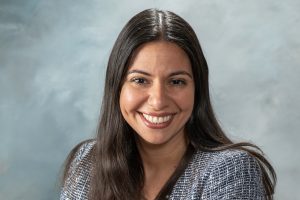
College of Nursing and Public Health Holds Discussion on Nurse Suicide Awareness and Prevention.

Marissa Abram ’08, PhD ’17
Marissa Abram ’08, PhD ’17, assistant professor in the College of Nursing and Public Health, opened her presentation, titled “A Safe Place: A Discussion of Nurse Suicide Prevention and Awareness,” by saying that suicide is “a leading cause of death, but it’s not discussed.” This event, she said, sought to “break the stigma.”
Dr. Abram, who is also program director of the College’s Psychiatric-Mental Health Nurse Practitioner program, alluded to a 2021 University of Michigan study that found female nurses are roughly twice as likely to die by suicide than the general female population and 70 times more likely than female physicians. But that study spanned 2007–2018 and so did not include the intensified stress brought on since 2020 by the COVID-19 pandemic.
Female nurses tend to use opioids, antidepressants and other substances, whereas male nurses are more likely to use firearms—though that’s on the rise among female nurses, she noted.
Even before COVID-19, Dr. Abram said, nurses’ workplaces were stressful for many reasons—from long work shifts to insufficient self-care—but the pandemic has significantly increased nurses’ risk of suicide.
Charles Cal ’95, MS ’01, MBA ’03, clinical assistant professor, who was among the 22 Zoom attendees, observed that nurses are less healthy than most, due to long hours of stressful work, workplace violence, musculoskeletal injuries and opioid abuse. He too mentioned studies from 2018 and earlier about the high prevalence of suicide among nurses and agreed that COVID-19 has only exacerbated that.
The April 28 virtual presentation also featured co-presenter Suede Graham, health educator with Adelphi’s Student Counseling Center. He said that nurses of color and those from historically underrepresented groups experience anxiety and burnout due to the added element of racism.
Abram added that the impact on nurses from turnover, hiring and training can also negatively affect not just themselves but their quality of care in treating patients.
Reaching College Students at Risk for Suicide

Suede Graham
The presenters expanded the scope of their session to encompass college students as another population segment at risk for suicide.
Graham said that 800,000 Americans die of suicide each year, the 10th leading cause of death, adding that 20 percent of those are in the 15-to-24-year-old bracket—high school and college age. Suicide, he noted, is the fourth leading cause of death among college students.
He also pointed out that 83 percent of college students who ended their lives never had prior contact with their university counseling center. It’s important that those who do make contact with students and sense something is amiss say something, Graham said. Another attendee, Marilyn Klainberg ’63, MS ’77, EdD, professor of nursing, said it could be merely asking, “How are you feeling?” That simple gesture might have more impact with a student than it would with, say, one’s friends or colleagues. Dr. Abram agreed, emphasizing that “instilling hope and connection” can prevent suicide.
Mary Jahrsdoerfer, PhD, clinical assistant professor, felt that the pandemic-driven move to online classes “makes it harder” to connect and support students than in-person contact, but added, “It’s critical to maintain a relationship.” Another participant, Virginia Oates, DNP, clinical assistant professor, said she has found that one-to-one online advisement sessions can be beneficial.
Graham, citing the importance of the “ask/persuade/assist” method of addressing suicide prevention, urged his audience to be aware of verbal, behavioral and situational clues exhibited by potential suicides. Behavioral clues can include giving away possessions, while situational clues could include the death of a family member or friend or a diagnosis of a serious or terminal disease, he noted.
“Your willingness to listen and to help can rekindle hope and make all the difference,” Graham said. “When you ask/persuade/assist, you plant the seeds of hope. Hope helps prevent suicide.”